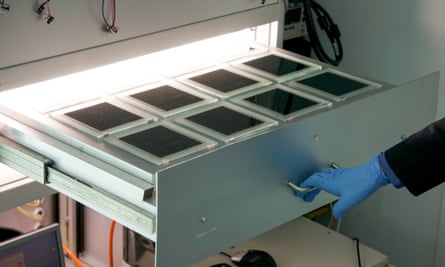With over 200 mostly sunny days a year, Australia’s nickname of the sunburnt country is well–earned. It’s therefore unsurprising that we lead the world in household solar, with 1.4m photovoltaic (PV) systems running in 2015.
By contrast however, Australia has relatively few large-scale solar farms, which the Clean Energy Council attributes to the “relatively high cost of the technology compared to more established forms of renewable energy”, such as wind power.
However, a new solar technology is being developed that could help to overcome this cost barrier, and bring about cheaper, and – potentially – less architecturally-intrusive solar energy. It’s called perovskite solar.
The technology essentially uses equal proportions of two other solar types (dye-sensitised solar cells and organic PV), and – even though it is still in development stage – has been of such interest to scientists, that Science magazine touted it as one of the top scientific breakthroughs of 2013.
To further the technology, the Australian Renewable Energy Agency (Arena) announced earlier this month that it would provide up to $892,000 to support the CSIRO in developing and applying guidelines for assessing the performance of perovskite solar cells, which could be quite high.
According to America’s National Renewable Energy Laboratory, these types of cells have increased their efficiency at converting sunlight to electricity from 3.8% in 2009 to over 20% today, and could potentially reach levels of 66% in the future.
To put that into context, traditional PV cells – which account for about 95% of the global market – have a benchmark of about 25%.
Damion Milliken, chief technical officer at Dyesol, a solar energy company developing perovskite solar in Australia with the help of $449,000 in Arena funding, says the increase in efficiencies is “astronomically quick in terms of PV”.
“Most things in this area take decades to go through this evolution”, he says. “Perovskite has the steepest inclination in efficiencies charted.”
Although perovskite solar works in the same way as traditional solar (capturing light and turning it into electricity), what makes it interesting is that it’s hundreds of times thinner than traditional PVs.
Milliken says: “A classic silicon device has a fairly thick layer in order to effectively capture light; around 150 microns [for context, a human hair is about 75 microns thick]. Perovskites are exceptionally strong light absorbers and can absorb the same amount of light with a layer of around 0.3 microns.”

“When you start to do the bill of materials analysis, you start to work out that the contacts are just a couple of dollars per square metre in terms of active material costs, which is spectacularly low. So, the panel costs half or less compared to traditional panels.”
Perovskites can also be chemically fine–tuned to change colour and transparency, and they can also be manufactured directly onto other structures, making them attractive for those wanting to integrate solar PV into buildings.
For example, solar panels could be placed directly onto glass facades and roller-coated materials, like roofing steel, at the point of manufacture. This could potentially mean greater uptake in solar on large commercial structures, like warehouses. They could also be potentially integrated into energy harvesting and storage systems for household generators.
“Most [solar panels] have to be fitted onto buildings after the fact, which incur extra costs in materials and labour”, Milliken says.
“Perovskites therefore have an extra arrow in the quiver for future expansion opportunities and for achieving things like zero net energy buildings, which will require something like this technology to be integrated into building envelopes.”
Tests on the durability and degradation of perovskite PVs are still underway across the globe, but results to date have been promising. In fact, Dyesol and UK company Oxford PV have been so impressed with the technology, that they are now racing to be the first to take perovskites to commercialisation by 2017.
Milliken says: “Around the world as a whole, solar still supplies less than 1% of global energy. So there’s not much uptake when you start to look at it holistically. To change that, it’s going to take a major upheaval unless new technology like perovskites are able to come in and save the day.
“If everything lines up, I think we could see a very disruptive and rapid advancement in the potential deployment of PV technology – from something that is a little bit of a byword in the global energy provision chain to something that is a real steamroller.
“It’s certainly going to be a game-changer for the solar market.”

Comments (…)
Sign in or create your Guardian account to join the discussion